1993 DODGE TRUCK torque
[x] Cancel search: torquePage 107 of 1502
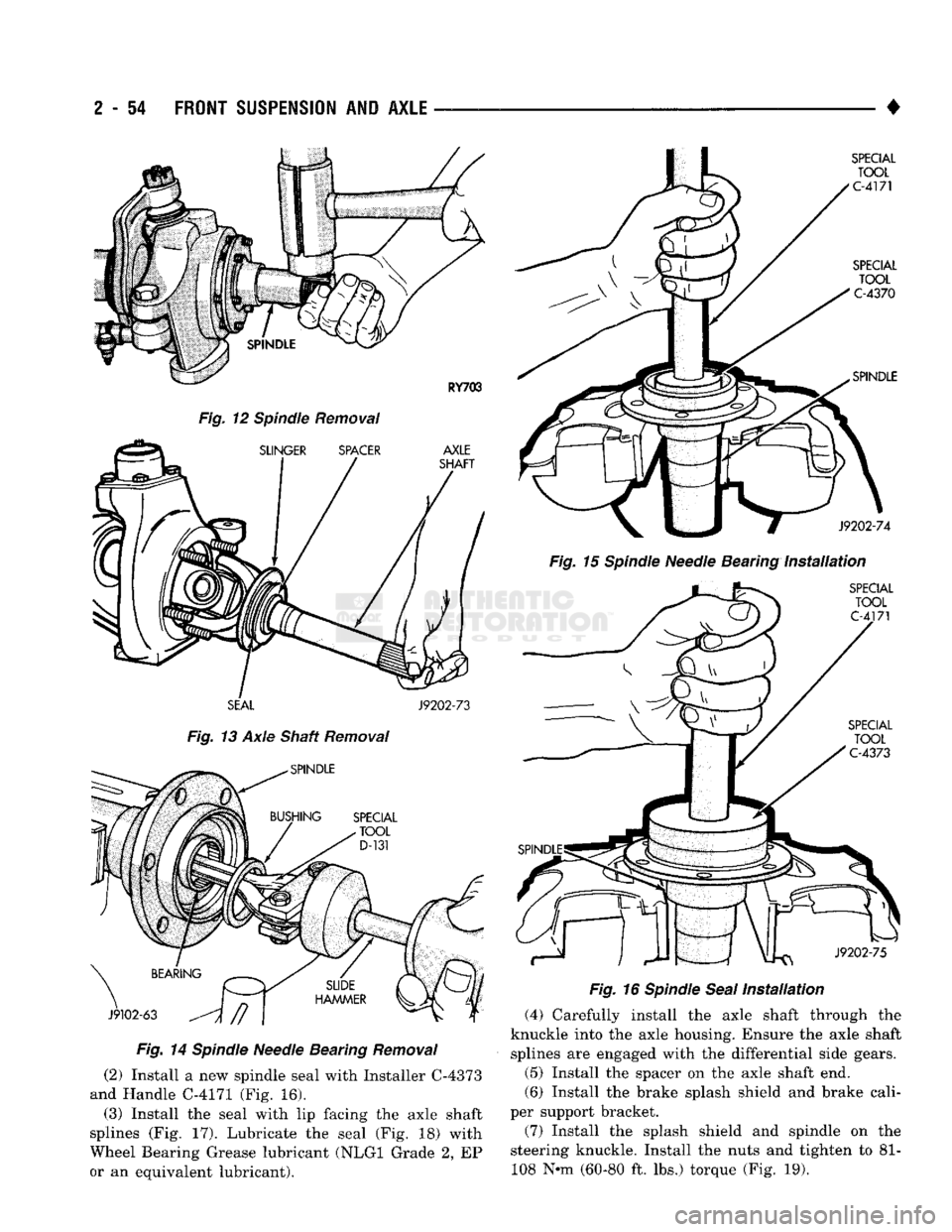
2
- 54
FRONT SUSPENSION
AND
AXLE
Fig.
12 Spindle Removal
SEAL
J9202-73
Fig.
13 Axle Shaft Removal
Fig.
14
Spindle
Needle Bearing
Removal
(2) Install a new spindle seal with Installer C-4373
and Handle C-4171 (Fig. 16).
(3) Install the seal with lip facing the axle shaft
splines (Fig. 17). Lubricate the seal (Fig. 18) with
Wheel Bearing Grease lubricant (NLGI Grade 2, EP
or an equivalent lubricant). •
Fig.
15
Spindle
Needle Bearing
Installation
Fig.
16
Spindle
Seal
Installation
(4) Carefully install the axle shaft through the
knuckle into the axle housing. Ensure the axle shaft splines are engaged with the differential side gears.
(5) Install the spacer on the axle shaft end.
(6) Install the brake splash shield and brake cali
per support bracket.
(7) Install the splash shield and spindle on the
steering knuckle. Install the nuts and tighten to 81- 108 N-m (60-80 ft. lbs.) torque (Fig. 19).
Page 108 of 1502
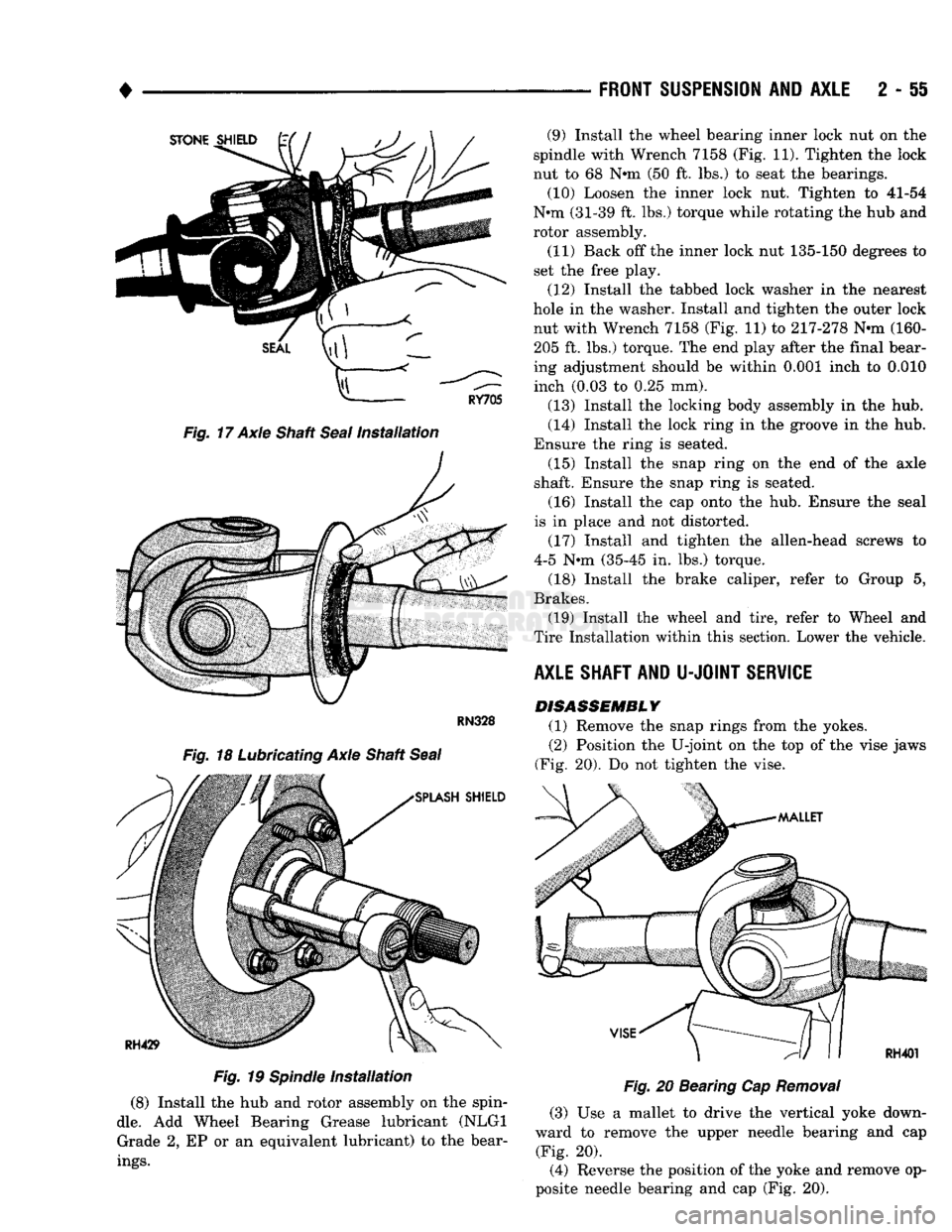
•
Fig.
17 Axle Shaft
Seal
Installation
Fig.
19
Spindle
Installation
(8) Install the hub and rotor assembly on the spin
dle.
Add Wheel Bearing Grease lubricant (NLGI Grade 2, EP or an equivalent lubricant) to the bear
ings.
FRONT
SUSPENSION
AND
AXLE
2 - 51
Fig.
20 Bearing Cap
Removal
(3) Use a mallet to drive the vertical yoke down
ward to remove the upper needle bearing and cap (Fig. 20).
(4) Reverse the position of the yoke and remove op
posite needle bearing and cap (Fig. 20). (9) Install the wheel bearing inner lock nut on the
spindle with Wrench 7158 (Fig. 11). Tighten the lock
nut to 68 N*m (50 ft. lbs.) to seat the bearings. (10) Loosen the inner lock nut. Tighten to 41-54
N*m (31-39 ft. lbs.) torque while rotating the hub and
rotor assembly.
(11) Back off the inner lock nut 135-150 degrees to
set the free play.
(12) Install the tabbed lock washer in the nearest
hole in the washer. Install and tighten the outer lock nut with Wrench 7158 (Fig. 11) to 217-278 N-m (160-205 ft. lbs.) torque. The end play after the final bear
ing adjustment should be within 0.001 inch to 0.010 inch (0.03 to 0.25 mm).
(13) Install the locking body assembly in the hub.
(14) Install the lock ring in the groove in the hub.
Ensure the ring is seated. (15) Install the snap ring on the end of the axle
shaft. Ensure the snap ring is seated.
(16) Install the cap onto the hub. Ensure the seal
is in place and not distorted.
(17) Install and tighten the allen-head screws to
4-5 N-m (35-45 in. lbs.) torque.
(18) Install the brake caliper, refer to Group 5,
Brakes. (19) Install the wheel and tire, refer to Wheel and
Tire Installation within this section. Lower the vehicle.
AXLE SHAFT AND
U-JOINT
SERVICE DISASSEMBLY
(1) Remove the snap rings from the yokes.
(2) Position the U-joint on the top of the vise jaws
(Fig. 20). Do not tighten the vise.
Page 110 of 1502
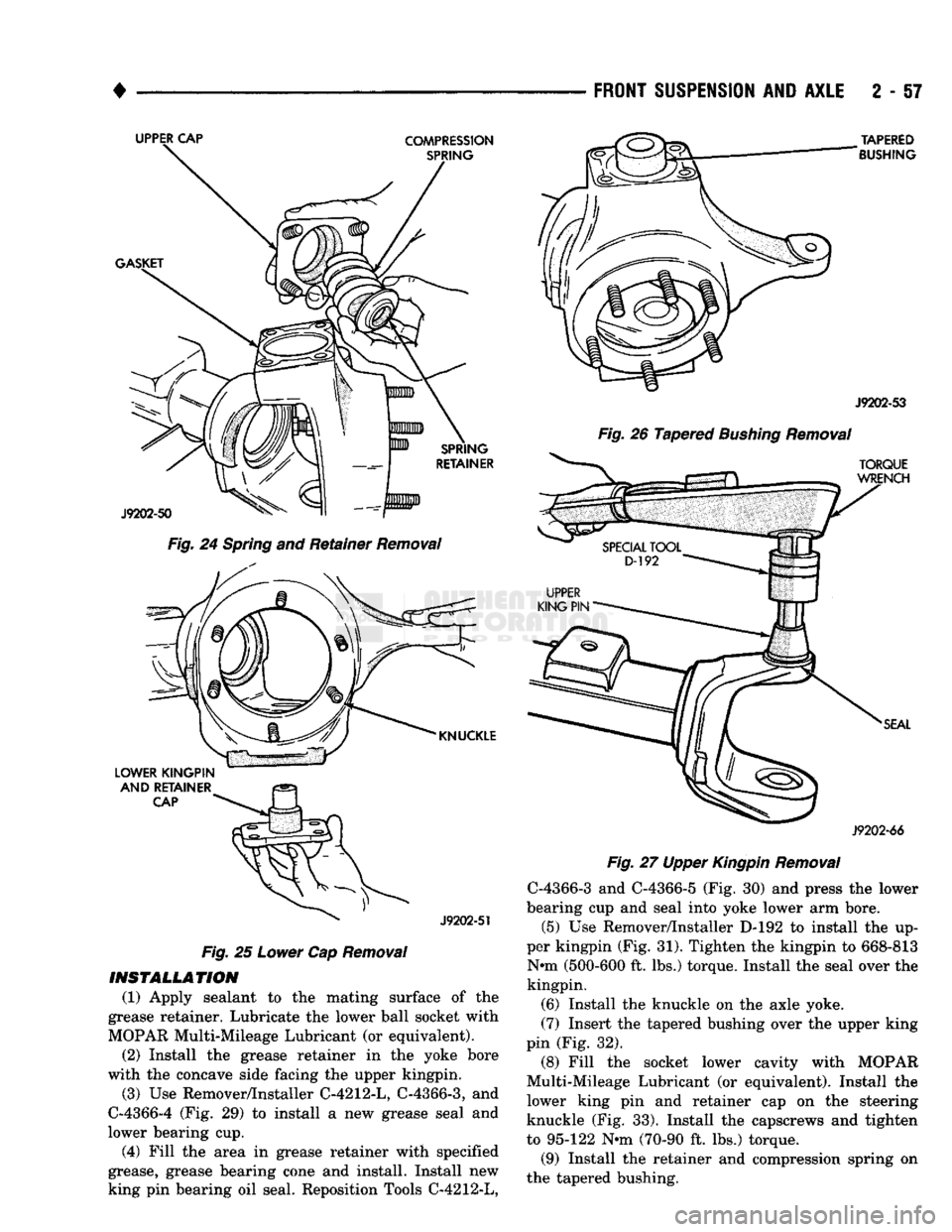
•
FRONT
SUSPENSION
AND
AXLE
2 - 57
Fig.
24
Spring
and Retainer
Removal
LOWER KINGPIN
AND
RETAINER
CAP
^
J9202-51
Fig.
25
Lower
Cap
Removal
INSTALLATION (1) Apply sealant to the mating surface of the
grease retainer. Lubricate the lower ball socket with
MOPAR Multi-Mileage Lubricant (or equivalent).
(2) Install the grease retainer in the yoke bore
with the concave side facing the upper kingpin.
(3) Use Remover/Installer C-4212-L, C-4366-3, and
C-4366-4 (Fig. 29) to install a new grease seal and
lower bearing cup.
(4) Fill the area in grease retainer with specified
grease, grease bearing cone and install. Install new
king pin bearing oil seal. Reposition Tools C-4212-L,
TAPERED
BUSHING
J9202-53
Fig.
26 Tapered
Bushing
Removal
J9202-66
Fig.
27 Upper
Kingpin
Removal
C-4366-3 and C-4366-5 (Fig. 30) and press the lower
bearing cup and seal into yoke lower arm bore.
(5) Use Remover/Installer D-192 to install the up
per kingpin (Fig. 31). Tighten the kingpin to 668-813 N-m (500-600 ft. lbs.) torque. Install the seal over the
kingpin.
(6) Install the knuckle on the axle yoke.
(7) Insert the tapered bushing over the upper king
pin (Fig. 32).
(8) Fill the socket lower cavity with MOPAR
Multi-Mileage Lubricant (or equivalent). Install the
lower king pin and retainer cap on the steering
knuckle (Fig. 33). Install the capscrews and tighten
to 95-122 N-m (70-90 ft. lbs.) torque.
(9) Install the retainer and compression spring on
the tapered bushing.
Page 111 of 1502
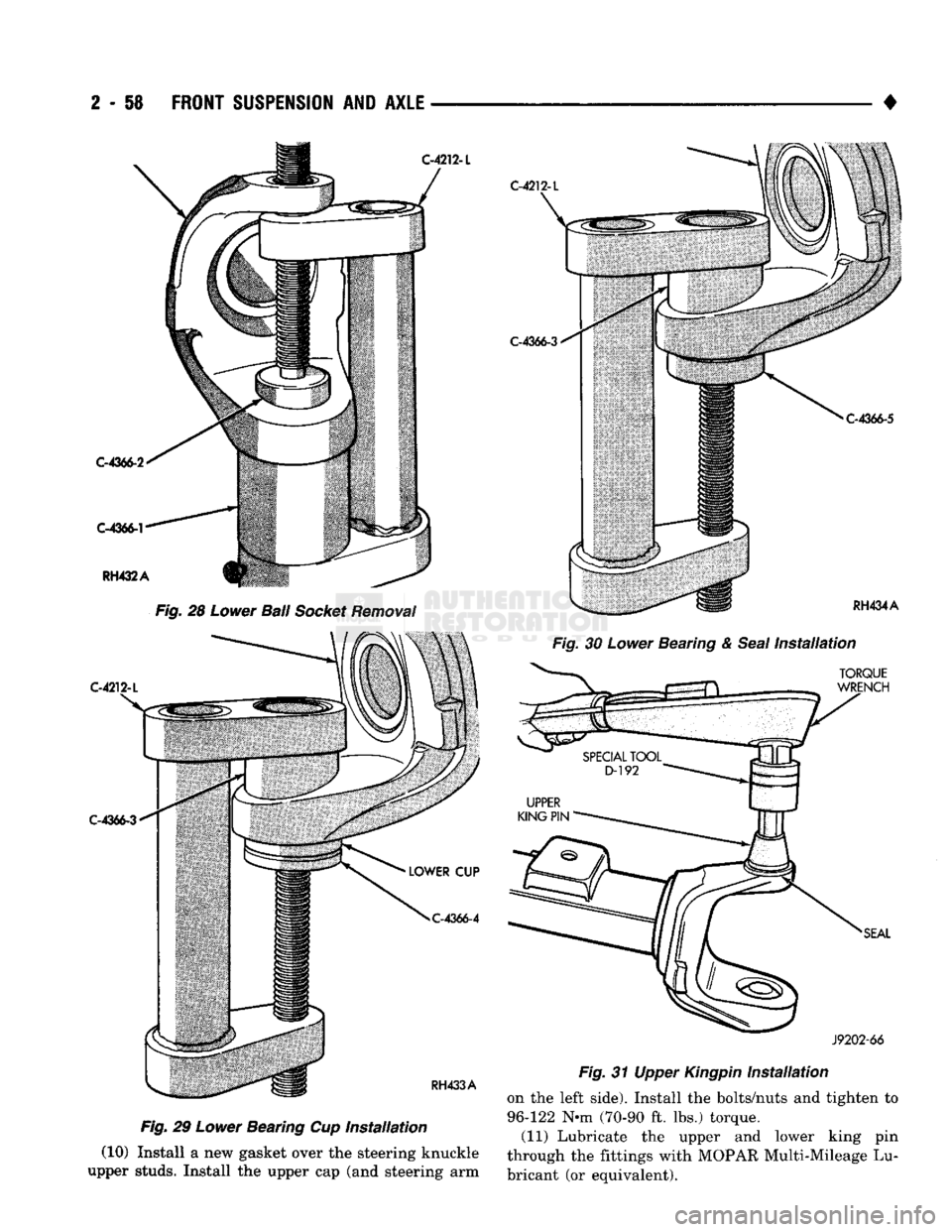
2
- 58
FRONT
SUSPENSION
AND
AXLE
•
C-4366-2
C-4366-1
RH432A
C-4212-L
Fig.
28
Lower
Ball
Socket
Removal
C-4212-L
C-4366-3
C-4366-4
RH433A
Fig.
29
Lower
Bearing Cup Installation
(10) Install a new gasket over the steering knuckle
upper studs. Install the upper cap (and steering arm
C-4212-L
C-4366-3
RH434A
Fig.
30
Lower
Bearing &
Seal
Installation
TORQUE
WRENCH
SEAL
J9202-66
Fig.
31 Upper
Kingpin
Installation
on the left side). Install the bolts/nuts and tighten to
96-122 N*m (70-90 ft. lbs.) torque. (11) Lubricate the upper and lower king pin
through the fittings with MOPAR Multi-Mileage Lu
bricant (or equivalent).
Page 112 of 1502

•
TAPERED
BUSHING
J9202-53
Fig.
32 Tapered
Bushing
Installation
J9202-52
Fig.
33
Lower
King
Pin and Retainer
Installation
(12) Install the axle shaft, refer to Axle Shaft and
U-Joint Installation.
COMPLETE
AXLE REMOVAL/INSTALLATION SERVICE
INFORMATION
It is not necessary to remove the complete front
axle from the vehicle for routine service. If the hous
ing or axle shaft tubes are damaged, the complete axle can be removed and installed via the following
procedures.
REMOVAL
(1) Block the brake pedal in the up position. Raise
and support the vehicle at a comfortable working
height.
(2) Remove the front wheels/tires.
FRONT SUSPENSION
AND
AXLE
2 - 59
(3) Mark the front drive shaft and the pinion yoke
for installation alignment reference.
(4) Disconnect the front drive shaft from the axle
yoke. Attach the drive shaft to the frame rail with
wire.
(5) Remove the cotter pin, the nut, and disconnect
the drag link from the steering knuckle arm (left side only). Discard the cotter pin.
(6) Disconnect flexible brake fluid hose fittings at
the frame crossmember. Plug the hoses at the fit
tings.
(7) Remove the shock absorber lower nut and stud
from the axle shaft tube bracket. Remove the nuts and disconnect the stabilizer bar links from the
spring brackets. (8) Remove nuts and the washers from the spring
U-bolts. Remove the complete front axle from the ve
hicle.
INSTALLATION (1) Position the front axle under the front of the
vehicle with the axle spring pads under the springs.
Place the spring brackets over the springs. Make sure the stabilizer bar link bolt holes face toward the
rear of the vehicle.
(2) Install the spring U-bolts, washers and nuts.
Refer to Front Suspension — 4WD Vehicles within
this group. (3) Install the shock absorber. Refer to Front Sus
pension—4 WD Vehicles within this group.
(4) Connect the stabilizer bar links to the spring
brackets. Refer to Front Suspension—4WD Vehicles within this group.
(5) Remove plugs and connect the brake hose fit
tings.
Refer to Group 5, Brakes. (6) Connect the drag-link ball stud to the steering
knuckle arm. Refer to Group 19, Steering. (7) Connect the drive shaft to the pinion yoke with
the installation reference marks aligned. Install the
washers and the nuts and tighten to 19 N-m (14 ft. lbs.) torque.
(8) Remove the supports, lower the vehicle and re
move the block from the brake pedal.
(9) Raise the vehicle.
• Bleed and adjust the brakes
• Lubricate all the ball stud fittings
• Inspect the differential housing lubricant level. Re
fer to Group 0, Lubrication and Maintenance.
(10) Lower the vehicle and test the axle and sus
pension operation.
DIFFERENTIAL DISASSEMBLY
REMOVAL/DISASSEMBLY
(1) Note the installation reference letters
stamped on the bearing caps and housing ma
chined sealing surface (Fig. 34).
(2) Remove the differential bearing caps.
Page 116 of 1502

•
FRONT SUSPENSION
AND
AXLE
2 - 63
THRUST
WASHER
Fig.
45
Pinion
Mate
Gear
Removal
• Bearing races must not be distorted or cracked
Cup and bearing must be replaced as a
matched set only. • All machined surfaces in the housing and on bear
ing caps should be smooth and without any raised
edges.
• Pinion gear front and rear bearing cup bores should be smooth
• Raised metal on shoulders of cup bores should be
removed with a hand stone.
(4) Examine the differential pinion gear mate
shaft, pinion gears, side gears and thrust washers for
wear and damage. Replace all defective components.
If either of the differential pinion gears is not
reusable, both gears must be replaced as a
matched set only. Do not replace only one gear.
(5) Examine the ring gear and the pinion gear for
worn and chipped teeth. Examine the ring gear for damaged bolt threads.
If replacement of either gear is necessary, both
must be replaced as a matched set only. (6) Inspect the pinion yoke for cracks, worn
splines, pitted areas, and a rough/corroded seal con
tact surface. Repair or replace the yoke as necessary. (7) Inspect the pinion bearing preload shims for
cracks, damage and distortion. Install replacement shims (if necessary) for the preload torque adjust
ment.
DIFFERENTIAL
ASSEMBLY
ASSEMBLY
(1) Install the following components in the differ
ential case (Fig. 47). • Differential side gears and thrust washers
• Pinion gears and thrust washers
• Pinion gear mate shaft (align holes in shaft and
case) (2) Install and seat the lock pin in the differential
case and mate shaft with a punch and hammer (Fig.
46).
Peen metal part of case over pin in two places. If replacement gears and thrust washers were
installed, it is not necessary to measure the gear
backlash. Correct fit is due to close machining tolerances during manufacture.
Fig.
46
Mate
Shaft Pin
Installation
(3) Invert the differential case and start two ring
gear bolts. This will provide case-to-ring gear bolt
hole alignment (Fig. 47). (4) Install new ring gear bolts and alternately
tighten to;
• Grade 8 bolts to 136-163 N*m (100-120 ft. lbs.)
torque
• Grade 9 bolts (7 radial lines) to 169-183 N*m (125- 135 ft. lbs.) torque.
(5) Lubricate all differential components with hy
poid gear lubricant. (6) Place Master Differential Bearing D-343
(D-117) on the case hubs (Fig. 48). (7) Install a pilot stud at the right side of housing.
Attach Dial Indicator C-3339 to the pilot stud. Load indicator plunger against the back of the ring gear (Fig. 49).
(8) Insert a small pry bar between the bearing cap
and right side of differential case. Pry the case as far
as possible to left side (Fig. 49). Zero the dial indica
tor pointer.
(9) Pry the case to right side and record the
travel distance.
Page 117 of 1502

2
- 64
FRONT
SUSPENSION
AND
AXLE
—
Fig.
47 Ring Gear Bolt Hole
installation
MASTER BEARING
RY652
Fig.
48 Master Bearing Tools On
Hubs
The measurement above is the shim thickness
necessary for case zero end-play. The total
thickness will be determined during the ring gear backlash adjustment. (10) Remove indicator and pilot stud.
PINION GEAR DEPTH INFORMATION Gears are supplied as matched sets only. The iden
tifying numbers for the ring and pinion gear are etched into the face of each gear (Fig. 50). A plus
(
+ )
number, minus (-) number or zero (0) is etched into •
Fig.
49
Differential
Case
End Play Measurement the face of the pinion gear. This number is the
amount (in thousandths of an inch) the depth varies
from the standard depth setting. The standard depth
provides the best teeth contact pattern.
DRIVE
PINION
Fig.
50
Pinion
Gear ID
Numbers
The standard depth is the distance (Fig. 51) from
the centerline of the axle shaft/ring gear to the shoulder of the rear pinion bearing.
• Model 60 axle, the standard depth/distance is
5.000
inches (127.0 mm).
Compensation for depth variance is achieved by
shims placed adjacent to the pinion gear rear bearing
cup (Fig. 52). If a new gear set is being installed, note the depth
variance etched into the original and new pinion gear. Add or subtract the thickness of the original
depth shims to compensate for the difference in the
depth variances. Refer to the Depth Variance charts.
TORQUE
Page 120 of 1502
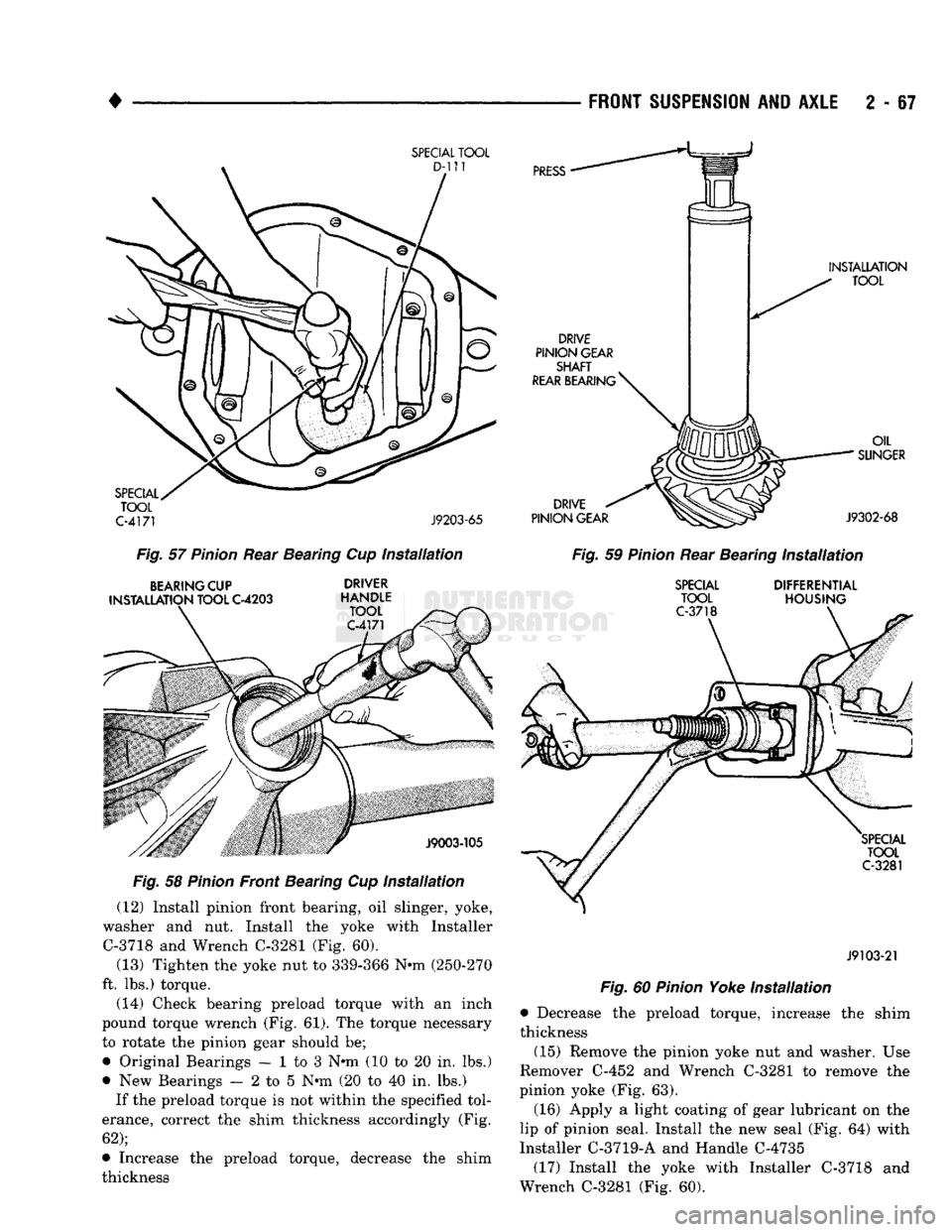
•
FRONT
SUSPENSION
AND
AXLE
2 - 67
SPECIAL
TOOL
D-111
PRESS
DRIVE
PINION GEAR SHAFT
REAR
BEARING' INSTALLATION
TOOL
SPECIAL
TOOL
C-4171
J9203-65
DRIVE
PINION GEAR OIL
SUNGER
J9302-68
Fig.
57
Pinion
Rear Bearing Cup
Installation
Fig.
59
Pinion
Rear Bearing
Installation
BEARING
CUP
INSTALLATION TOOL
C-4203
DRIVER
HANDLE TOOL
C-4171
SPECIAL
TOOL
C-3718
DIFFERENTIAL
HOUSING
SPECIAL
TOOL
C-3281
Fig.
58
Pinion
Front Bearing Cup
Installation
(12) Install pinion front bearing, oil slinger, yoke,
washer and nut. Install the yoke with Installer C-3718 and Wrench C-3281 (Fig. 60).
(13) Tighten the yoke nut to 339-366 N-m (250-270
ft. lbs.) torque. (14) Check bearing preload torque with an inch
pound torque wrench (Fig. 61). The torque necessary
to rotate the pinion gear should be;
• Original Bearings — 1 to 3 N*m (10 to 20 in. lbs.)
• New Bearings — 2 to 5 N-m (20 to 40 in. lbs.) If the preload torque is not within the specified tol
erance, correct the shim thickness accordingly (Fig.
62);
• Increase the preload torque, decrease the shim
thickness
J9103-21
Fig.
60
Pinion
Yoke
Installation
• Decrease the preload torque, increase the shim
thickness (15) Remove the pinion yoke nut and washer. Use
Remover C-452 and Wrench C-3281 to remove the
pinion yoke (Fig. 63).
(16) Apply a light coating of gear lubricant on the
lip of pinion seal. Install the new seal (Fig. 64) with
Installer C-3719-A and Handle C-4735
(17) Install the yoke with Installer C-3718 and
Wrench C-3281 (Fig. 60).